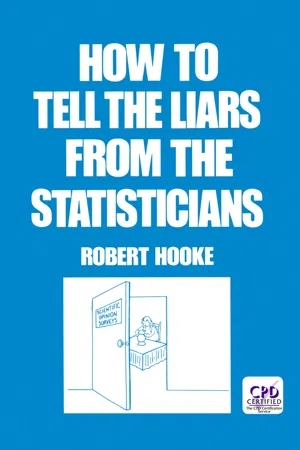
This is a test
- 192 pages
- English
- PDF
- Available on iOS & Android
eBook - PDF
How to Tell the Liars from the Statisticians
Book details
Table of contents
Citations
About This Book
This book shows how statistical reasoning affects all aspects of our lives. It touches on drug testing, discrimination, sports, political polls, compulsive gambling, gun detectors, cancer research, crime and punishment, opinion surveys, advertising, mass production, and doctors' waiting rooms.
Frequently asked questions
At the moment all of our mobile-responsive ePub books are available to download via the app. Most of our PDFs are also available to download and we're working on making the final remaining ones downloadable now. Learn more here.
Both plans give you full access to the library and all of Perlego’s features. The only differences are the price and subscription period: With the annual plan you’ll save around 30% compared to 12 months on the monthly plan.
We are an online textbook subscription service, where you can get access to an entire online library for less than the price of a single book per month. With over 1 million books across 1000+ topics, we’ve got you covered! Learn more here.
Look out for the read-aloud symbol on your next book to see if you can listen to it. The read-aloud tool reads text aloud for you, highlighting the text as it is being read. You can pause it, speed it up and slow it down. Learn more here.
Yes, you can access How to Tell the Liars from the Statisticians by Robert Hooke in PDF and/or ePUB format, as well as other popular books in Mathematics & Probability & Statistics. We have over one million books available in our catalogue for you to explore.
Information
Table of contents
- Cover
- Half Title
- Popular Statistics
- Title
- Copyright
- Dedication
- Abstract
- Preface
- Contents
- About the Series
- Chapter 1 Statistics Are - Statistics Is
- Chapter 2 Worry
- Chapter 3 More on Worry
- Chapter 4 Statistics and Chances
- Chapter 5 Measuring Chances
- Chapter 6 Chances and Drug Laws
- Chapter 7 The Broad-Base Fallacy
- Chapter 8 The Unmentioned Base
- Chapter 9 The Elmer Gantry Effect
- Chapter 10 When the Truth Is notthe Whole Truth
- Chapter 11Ceteris Paribus
- Chapter 12 Statistics of Discrimination
- Chapter 13 A Paradox in DiscriminationStatistics
- Chapter 14 Smoking and Cancer
- Chapter 15 People Are Different
- Chapter 16 Risk Taking in Industry
- Chapter 17 The Risk Taker's Image
- Chapter 18 When Should We TakeChances?
- Chpater 19 Cost Accounting
- Chapter 20 Bridges, Underpasses, andCorporate Profits
- Chapter 21 Are You Average Enough?
- Chapter 22 Infatuation with Averages
- Chapter 23 The Law of Averages,Compulsive Gambling,and the Rubber Band Theory
- Chapter 24 A Rational View of Luck
- Chapter 25 Luck and Skill CombinedThe Regression Fallacy andthe Sophomore Jinx
- Chapter 26 Luck and Dependence
- Chapter 27 Confidence and Dependence
- Chapter 28 sports "Form" andConsistency
- Chapter 29 Who Is Unemployed?
- Chapter 30 Cost of Living
- Chapter 31 Trade-Offs
- Chapter 32 False AlarmsOr Type I Errors
- Chapter 33 Liberals and Conservatives
- Chapter 34 One-Armed Consultants
- Chapter 35 The GGFTGN, the Billof Rights, and Other Things
- Chapter 36 Things to Think about whileWaiting to See the Doctor
- Chapter 37 Zero or Nothing?
- Chapter 38 Quality Control and "ZeroDefects"
- Chapter 39 Scaling Up and Down
- Chapter 40 More Is Less
- Chapter 41 Large Samples and Bad News
- Chpater 42 Rare Floods, Rare Scientists,and Frustrated Authors
- Chapter 43 The World Is Getting Smaller
- Chapter 44 Population Size andthe Quality of Life
- Chapter 45 Raisins, Nuts, and Samples
- Chpater 46 Political Polls
- Chapter 47 Opinion Surveys
- Chapter 48 Television Ratings - Moreof the Same
- Chapter 49 The Significance ofSignificance
- Chapter 50 Garbage In - Garbage Out
- Chapter 51 The Double Negativeand the Consumer
- Chapter 52 The Douhle Negativeand Social Science
- Chapter 53 What Is Correlation?
- Chapter 54 The Coin that Won't Standon Edge
- Chapter 55 Guilt hy Association
- Chapter 56 Psychological Testsand Job Success
- Chapter 57 Credit and Your Computer Kin
- Chapter 58 College Entrance Tests
- Chapter 59 Science and Statistics
- Chapter 60 The Scientific MethodAuthoritarianism In and Outof Science
- Chapter 61 Looking Backwardvs. Looking Forward
- Chapter 62 Controlled Experimentation
- Chapter 63 Cause and Effect
- Chapter 64 Value Judgments andPlanning
- Chapter 65 Serendipity - Putteringvs. Planning
- Chapter 66 Unconscious Dishonesty
- Chapter 67 Watch Out for 670/0
- Chapter 68 What ExperimentersCan Learn fromFootball and Card Players
- Chapter 69 A Digression on Random Digitsand Computer Simulation
- Chapter 70 Generalizations
- Chapter 71 Within vs. BetweenFrom Toothpaste to Static
- Chapter 72 A Thought About Stereotypes
- Chapter 73 Longevity at the Hot Corner
- Chapter 74 Let's Save Some Money
- Chapter 75 There Are No Easy Solutions
- Chapter 76 Separating the Liarsfrom the Statisticians
- Index